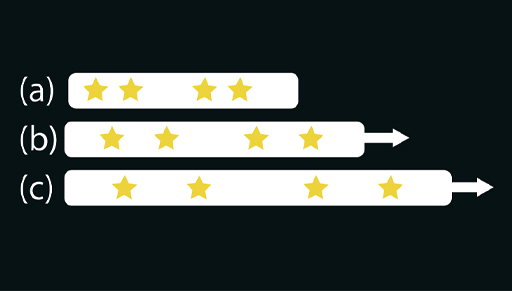7 The wider universe
It’s been established that the universe is expanding. This was first discovered by Edwin Hubble in the 1920s, who noticed that almost all the galaxies in the sky appeared to be moving away from us. And the more distant the galaxy, the faster it was moving away.
This isn’t because the Earth is uniquely unpopular in the universe! Indeed, the whole of the universe is expanding uniformly – every cluster of galaxies is moving away from every other cluster. Wherever you may be in the universe, you will see galaxies moving away at a speed proportional to their distance from you.
To help you visualise uniform expansion, have a go at this practical activity.
Activity 2 An elastic analogy
Find a piece of elastic, or an elastic band. Use a marker pen or ballpoint to make several dots along its length to represent galaxies in space. Then stretch the elastic out. As you do this, what do you notice?
Discussion
As you stretch the elastic, you should notice how the dots move apart. Each dot sees the neighbouring dots moving away at a speed proportional to their distance. The expansion of the universe works similarly. You can think of the galaxies being carried along by the expansion of space.
Figure 9 demonstrates how this works. In (a) ‘galaxies’ are marked along a piece of elastic. As the elastic is stretched (b) the galaxies move apart. In (c) all the distance have doubled as the ‘universe’ continues to expand. Note that each galaxy will see the others moving away at a speed proportional to their distance.
Today, this expansion is understood through the theory of general relativity, devised by Albert Einstein in the early 20th century. He demonstrated a direct connection between the average density of matter and energy in the universe and its fate. If the density is lower than a certain ‘critical density’, this is indicative of an ‘open’ and infinite universe which will expand forever. If, on the other hand, the density is greater than the critical value, this is indicative of a ‘closed’ and finite universe, where the expansion will eventually stop and go into reverse. Measuring the average density would tell us whether our universe is open or closed.
This critical density threshold is very small in itself – equivalent to just six atoms of hydrogen in a cubic metre. Until the late 1990s, the average density of all the matter we could see appeared to be somewhat less than that, indicating that the expansion would go on forever. This is still true when taking ‘dark’ matter into account, which is invisible to us but detectable from its gravitational pull. But the measured density was close enough to the critical density to present an intriguing puzzle.
Then, in 1998, two research groups discovered from observations of distant supernovae that the expansion of the universe was slower in the past than it is now. This is quite the opposite of the theoretical predictions – why should the expansion be speeding up? This implies that something is continuing to drive the expansion. That ‘something’ has been given the name ‘dark energy’. There’s not enough room in this course to discuss what that energy might be, but the idea is that it permeates all of space. (Oddly enough, Einstein proposed something very similar about a century ago but later discounted it as implausible.)
It’s now thought that dark energy accounts for about 70% of the density of the universe, with the other 30% being due to matter. Together they add up to a value very close to the critical density. But the accelerating effect of dark energy means that the critical density is no longer a simple criterion for whether the universe will keep expanding. The discovery of dark energy almost certainly points to a future of indefinite and accelerating expansion.

